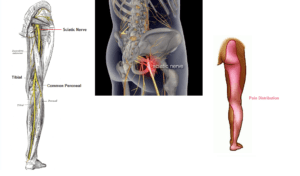What is Sciatica?
![sciatica_diagram [Converted]](https://www.robinkiashek.co.uk/wp-content/uploads/2018/12/sciatica_diagram-Converted-251x300.jpg)
Sciatica (or in layman’s terminology lumbago) is a common nerve pain, which is a symptom of an underlying condition that affects the back, hips and legs. It is characterised by a pain accompanied sometimes by pins & needles and/or numbness and/or weakness in the legs. Sometimes the pain affects both legs, and though it most commonly runs down the back of the legs, it can manifest at the front or side too. The cause of the symptoms is irritation or compression of the sciatic nerve.
What is the sciatic nerve?
The sciatic nerve is the longest nerve in the human body, beginning at lower spinal region, running through the buttocks and extends right down the length of the leg to the feet. The symptoms (pain/pins & needles/numbness/weakness) can be felt either locally in the lower back or anywhere along the course of the sciatic nerve (as far as the feet). Other areas, including the genital region, can also be affected.
How do you get sciatica?
In most cases sciatica is caused by an irritation or compression of the sciatic nerve, commonly a bulging disc in the lower (Lumbar) spine. Discs are very special shock-absorbing, cushioning tissue structures, which sit between the vertebrae (the bones that make up the spinal column). Structurally, discs can the thought of as having an inner soft core (nucleous pulposus) surrounded by tough circular outer fibres (nucleous fibrosus), the outer fibres holding in place the softer inner core. Typically, over a period of time, the outer surrounding fibres develop micro tears due to, for example, poor posture or overloading over a long period of time (see the June blog article ‘The Dripping Tap Syndrome’). Bearing in mind the lower spinal discs absorb most of the upper body weight, these micro fissures in the outer fibres begin to allow the inner soft core to bulge outwards through the tougher outer fibres, resulting in a ‘disc bulge’, which in turn can begin to impinge on the surrounding tissues, including the sciatic nerve (this scenario is commonly eroneously called a ‘trapped nerve’).
How is sciatica treated?
 Here at the Robin Kiashek Clinics we promote prevention, and have plenty of advice on keeping your spine healthy and pain-free (see our recent article ’10 Tips for Maintaining a Healthy Spine’). However, if you are either experiencing symptoms, no matter how mild, or would like an assessment, an initial consultation should be considered. Robin will take a full case history followed by a clinical examination, which will provide you with a ‘working diagnosis’ of your situation.
Here at the Robin Kiashek Clinics we promote prevention, and have plenty of advice on keeping your spine healthy and pain-free (see our recent article ’10 Tips for Maintaining a Healthy Spine’). However, if you are either experiencing symptoms, no matter how mild, or would like an assessment, an initial consultation should be considered. Robin will take a full case history followed by a clinical examination, which will provide you with a ‘working diagnosis’ of your situation.
You will get a care plan for your treatment, which may include a couple of follow up appointments, and you will get plenty of guidance on understanding pain, and will be given a strategy to move your recovery forward, including advice on exercise.
For more information on sciatica or to book an appointment with Robin, please call 020 8815 0979.







